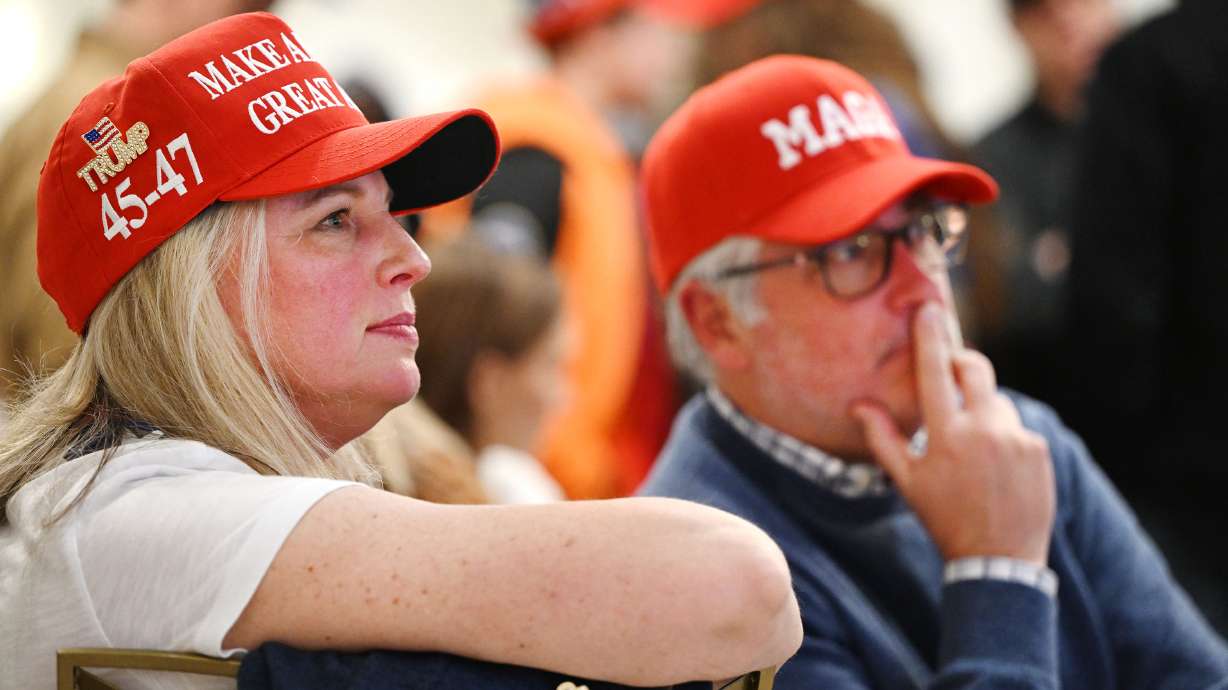Estimated read time: 4-5 minutes
This archived news story is available only for your personal, non-commercial use. Information in the story may be outdated or superseded by additional information. Reading or replaying the story in its archived form does not constitute a republication of the story.
- Donald Trump slightly improved his Utah vote share compared to 2020.
- He leads Kamala Harris by over 20 points, but trails the percentages of other Republicans in major races.
- Salt Lake County shows ticket-splitting, with Democrats and Republicans both performing well.
SALT LAKE CITY — Donald Trump has slightly improved his vote share in Utah compared to four years ago, but is still running a few points behind most major Republican candidates in the state, according to the latest preliminary election results.
Trump is on pace to earn about 59% of the vote in Utah as of Friday afternoon, which would put him ahead of the 58% he earned in 2020. The former president and president-elect leads Democratic Vice President Kamala Harris by more than 20 points in the conservative state, but trails several other top Republican candidates in terms of vote share.
Rep. John Curtis, a Republican congressman, was elected this week to the U.S. Senate with more than 62% of the vote statewide, and three of the four Republican candidates for the U.S. House of Representatives are winning with at least 62% of the vote. Rep. Celeste Maloy is an exception — she won reelection in the 2nd Congressional District with about 58% of the vote.
Trump is also outpacing Gov. Spencer Cox's reelection bid, primarily because state Rep. Phil Lyman, R-Blanding, launched a write-in campaign after losing to Cox in the GOP primary. Lyman's efforts have netted him more than 9% of the vote so far — most of which would likely go to Cox if Lyman were not running.
If Lyman's 9% were added to Cox's 55.65%, Cox would have among the highest shares of votes among statewide and federal candidates this cycle, and would be outperforming the 63% he won with four years ago.
Matt Lusty, Cox's campaign manager, said Trump's improvement since 2020 shows he is becoming more normalized within the party, but his relatively lower support in Utah is evidence that the state is still not as full-throated in its support of the three-time Republican nominee.
"His image has been rehabbed in a way that's almost unfathomable," Lusty told KSL.com. "But, that doesn't mean that people are just wrapping their arms around him. There's a really big piece of the electorate that is going, 'I'm voting for this guy, but not because I'm enamored by Donald Trump. I'm voting for this guy because I can't afford my trip to the grocer.'"
Trump is running even or ahead of other Republicans in several rural and southern Utah counties, but is underperforming in the more populous counties along the Wasatch Front.
Here is how Trump's vote share compares with Curtis' in the four most populous counties in Utah — which combined make up nearly three-quarters of all residents — as of 4 p.m. on Friday:
- Salt Lake County: Curtis 48.33%, Trump 43.36%
- Utah County: Curtis 73.32%, Trump 67.73%
- Davis County: Curtis 65.52%, Trump 60.67%
- Weber County: Curtis 62.12%, Trump 59.7%
Harris, meanwhile, has also improved marginally over President Joe Biden's numbers from 2020, and is running ahead of other Democrats in the state. Her vote share this year is just shy of 38.5%, up from Biden's 37.65% in 2020. That outpaces Democratic Senate candidate Caroline Gleich and gubernatorial candidate Brian King, both of whom are in the low 30s.
Read more:
Splitting tickets in Salt Lake County
Harris is on track to win only three of Utah's 29 counties: Salt Lake, Summit and Grand. While Democrats outperformed Republicans in every federal and statewide race in Summit and Grand counties, Salt Lake County voters appear to have been more likely to split their ballots between Republicans and Democrats.
Harris holds a 10-point lead over Trump in the county and Democratic Salt Lake County Mayor Jenny Wilson leads Republican Erin Rider by a similar margin, but both Cox and Curtis hold incredibly narrow leads over their Democratic opponents as of Friday afternoon. The governor won the county in 2020 so it's not surprising he and Curtis are ahead this year, but it shows that Salt Lake County is one of the few remaining places where candidates from both parties can perform well at the top of the ticket.
"Utahns have historically been ticket-splitters, and I think what we are seeing is that Salt Lake County is purple on its best day," said Ben Haynes, a senior partner at Elevate Strategies, a consulting firm focused on supporting progressive candidates for office.
Haynes made clear that the results are still preliminary, and that the outcomes will be more clear once the election has been certified.
"I think there are a lot of moderate (Democrats) that don't mind voting for Republicans, and Republicans who are warming to (Democrats) they trust," he added.
Lusty said voters in the county are also likely differentiating between Trump and other Republicans, such as Cox. He referenced the common maxim that "all politics is local."
"It's not exactly true, but Spencer Cox is a Utah brand. He's well-known to Utah," he said. "People know that he looks, acts, smells like a Utahn, versus a New York real estate developer that is very different than us."
Correction: An earlier version incorrectly stated that Rep. Celeste Maloy won her race for Utah's 3rd Congressional District. Maloy represents the 2nd Congressional District.











